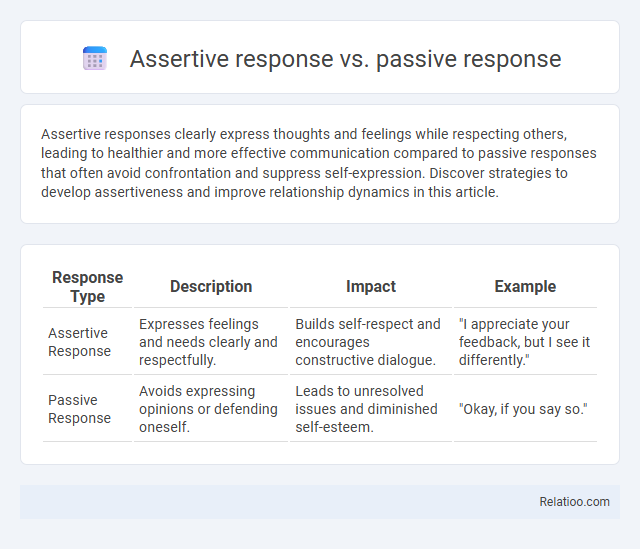Assertive responses clearly express thoughts and feelings while respecting others, leading to healthier and more effective communication compared to passive responses that often avoid confrontation and suppress self-expression. Discover strategies to develop assertiveness and improve relationship dynamics in this article.
Table of Comparison
| Response Type | Description | Impact | Example |
|---|---|---|---|
| Assertive Response | Expresses feelings and needs clearly and respectfully. | Builds self-respect and encourages constructive dialogue. | "I appreciate your feedback, but I see it differently." |
| Passive Response | Avoids expressing opinions or defending oneself. | Leads to unresolved issues and diminished self-esteem. | "Okay, if you say so." |
Understanding Assertive and Passive Responses
Assertive responses clearly express thoughts and feelings while respecting others, enhancing effective communication and conflict resolution. Passive responses often avoid confrontation by withholding opinions or needs, leading to misunderstandings and unaddressed issues. Mutual understanding emerges when individuals recognize and balance assertive and passive communication styles, fostering empathy and cooperation.
Key Differences Between Assertive and Passive Communication
Assertive communication clearly expresses thoughts, feelings, and needs while respecting others, whereas passive communication avoids confrontation and often leads to unexpressed emotions or resentment. Assertiveness promotes mutual understanding by encouraging open, honest dialogue, while passive responses may result in misunderstandings and unresolved conflicts. Key differences include the level of self-expression, confidence, and respect for boundaries, with assertiveness fostering balanced interactions and passive responses risking miscommunication.
Psychological Impact of Assertive vs Passive Responses
Assertive responses foster psychological empowerment by promoting clear communication, self-confidence, and emotional regulation, reducing anxiety and resentment. Passive responses often lead to suppressed emotions, increased stress, and lowered self-esteem due to unexpressed needs and feelings. Mutual understanding builds on assertiveness, facilitating empathy and collaboration that further enhances mental well-being and interpersonal relationships.
Benefits of Assertive Responses in Daily Life
Assertive responses promote clear communication by expressing your thoughts and feelings directly while respecting others, reducing misunderstandings and enhancing relationships. They increase self-confidence and decision-making skills, leading to more effective problem-solving in daily interactions. By fostering mutual respect, assertive communication helps create a balanced environment where everyone's needs are acknowledged and addressed.
Risks of Passive Responses in Relationships
Passive responses in relationships often lead to unresolved conflicts and emotional buildup, increasing the risk of resentment and miscommunication. Your feelings and needs may be overlooked, resulting in decreased self-esteem and dissatisfaction within the partnership. Embracing mutual understanding fosters open dialogue and balanced assertiveness, preventing the negative consequences associated with passivity and promoting healthier connections.
Common Traits of Assertive Individuals
Assertive individuals consistently express their thoughts and feelings clearly while respecting others' viewpoints, balancing confidence with empathy. You demonstrate mutual understanding through open communication and active listening, which helps resolve conflicts effectively without aggression or passivity. Common traits include self-assurance, emotional intelligence, and the ability to set boundaries while fostering cooperative interactions.
Signs You May Be Responding Passively
Signs you may be responding passively include avoiding eye contact, using apologetic language, and failing to express your true feelings or needs. Passive responses often involve agreeing unwillingly, hesitating to share opinions, and letting others dominate conversations, which can lead to frustration and resentment. Developing a mutual understanding requires moving beyond these passive behaviors toward assertive communication that respects your boundaries and encourages open dialogue.
Techniques to Develop Assertive Responses
Developing assertive responses involves practicing clear and direct communication techniques such as using "I" statements to express feelings and needs without aggression or passivity. Role-playing scenarios and maintaining steady eye contact enhance confidence and clarity during interactions. Mutual understanding is achieved when assertiveness is balanced with active listening, promoting respect and collaborative problem-solving.
Overcoming Barriers to Assertiveness
Overcoming barriers to assertiveness involves recognizing the differences between assertive, passive, and mutual understanding responses. An assertive response clearly expresses Your needs and rights while respecting others, unlike a passive response, which often leads to unspoken frustrations and unmet needs. Cultivating mutual understanding fosters open communication by balancing assertiveness with empathy, helping to break down emotional and social barriers to effective dialogue.
Real-Life Scenarios: Assertive vs Passive Responses
In real-life scenarios, an assertive response clearly communicates Your needs and boundaries while respecting others, promoting effective problem-solving and confidence. A passive response often avoids confrontation, leading to unmet needs and potential resentment or misunderstanding. Mutual understanding arises when both parties engage assertively, fostering collaboration and positive relationships.

Infographic: Assertive response vs Passive response
 relatioo.com
relatioo.com